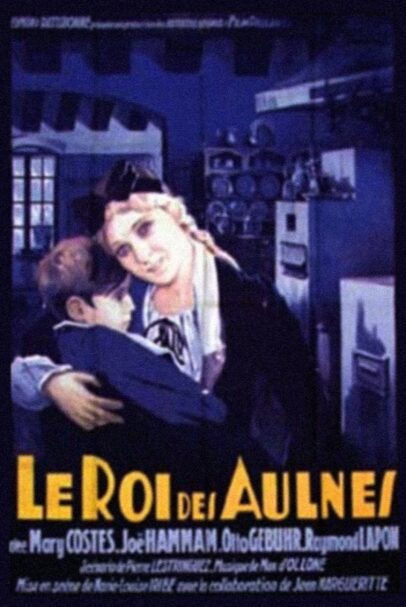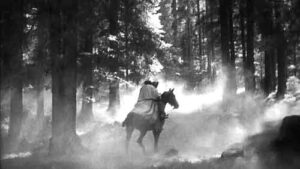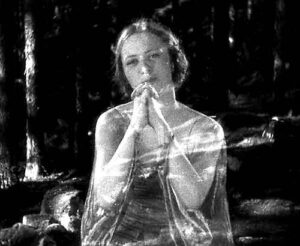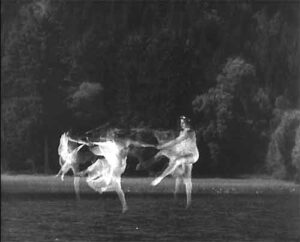This 45-minute film from 1931 begins with a French translation of the 1782 Johann Wolfgang von Goethe poem “The Erl-King,” about a desperate man on a nighttime dash to save his dying son from the spectral title character, the king of the fairies. The poem’s inclusion is questionable, as it shows that the material is extremely thin from a conceptual standpoint and, even worse, it gives away the ending.
“THE ERL-KING,” based on the folklore-inspired Danish ballad ELVESKUD, has inspired quite a few interpretations over the years that encompass film, music and the graphic arts (I’m especially partial to John Bolton’s peerlessly nightmarish six page graphic adaptation, found in the 1989 anthology SATURDAY MOURNING: FLY IN MY EYE). This French language film adaptation, released alongside a simultaneously filmed German language version entitled DER ERLKÖNIG, took Franz Schubert’s 1815 musical adaptation of Geothe’s ballad as partial inspiration. The helmer was Marie-Louise Iribe (1894-1934), an actress turned director whose career was cut short by her untimely death at age 39.
A man (Otto Gebuhr) is seen on a desperate horseback ride through a forbidding wilderness with his ailing son (Raymond Lapon) in tow. When the horse drops dead from exhaustion the man is forced to carry the boy to a village whose kindly inhabitants provide another horse. A malevolent toad, meanwhile, follows father and son through the surrounding marshland and transforms itself into a human-sized creature, it being one of several unearthly beings populating this landscape.
Eventually father and son enter a mist-shrouded forest the latter claims “belongs to the Erl-King,” a notion his father dismisses. But the supernatural is evident in the form of spectral fairies the boy sees dancing in the forest, mermaids in the river and the Erl-King himself, who takes the form of a ghostly knight that pursues the protagonists through the nocturnal landscape, and eventually reaches into the boy’s chest and stops his heart—and so, in the words of Goethe, “The father, speeding, The moaning child in his arms, Arriving in exhaustion and dread; But in his arms the child lies dead.”
Much of the above is quite blatantly padded, with the events of Goethe’s poem contained in the last five minutes of the film. Yet the great beauty of the French countryside, presented in luminous black and white, maintains one’s attention, as do the special effects, consisting of superimpositions straight out of the silent era in which Marie-Louise Iribe got her start. Those effects tend to show their age, although some, such as the see-through fairies dancing amid the trees and lounging at the bottom of a river, remain quite striking.
For much of its runtime the film would appear to consciously eschew the horror label in favor of poetic fantasy not too far removed from the films of Jean Cocteau (such as THE BLOOD OF A POET/Le sang d’un poète, 1932, and BEAUTY AND THE BEAST/La Belle et la Bête, 1946). Yet the proceedings gain in intensity and, as in the poem, conclude in authentically horrific fashion.
Vital Statistics
THE ERL-KING (LE ROI DES AUNES)
Les Artistes Reunis
Director: Marie-Louise Iribe
Producer: Edmond Ratisbonne
Screenplay: Pierre Lestringuez, Peter Paul Brauer, Marie-Louise Iribe
(Based on a poem by Johann Wolfgang Goethe)
Cinematography: Robert Batton
Cast: Joe Hamman, Otto Gebuhr, Mary Costes, Raymond Lapon, Louis Melrak, Rosa Bertens, Arlette Porta, Andre Michaud, Albert Broquin




